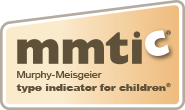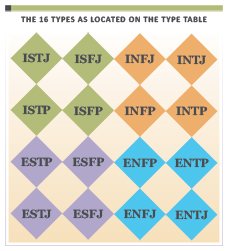An MMTIC® Practitioner’s Insights on the Value of Type Awareness for Young People
Working as an MMTIC® Certified Practitioner is an incredibly rewarding experience, and I feel honored to provide this service for students and families. This kind of work aligns with my personality type preference for INFP (Introversion, Intuition, Feeling, Perceiving); helping people discover their potential and explore future possibilities resonates with me. I have the privilege of witnessing the “lightbulb moments” for students and often parents, too. When I first learned about personality type as a young adult, I felt very validated about who I am as a person, and being able to facilitate that experience for others is incredible. Helping others appreciate and affirm who they are naturally is a core value of mine, which is why I love the work that I do.
At the beginning of each MMTIC feedback session, I often ask a few questions to help guide my feedback. In one session, a high school student shared an interest in robotics and engineering. After we discovered his personality type preference for ISTJ (Introversion, Sensing, Thinking, Judging), and discussed careers, he saw that one of the more popular occupations for his personality type was engineering. He shared a sense of validation that he was on the right path. He was already looking at top engineering programs in the country.
His parents were excited for him and gained insights as well. Both parents shared that they preferred Extraversion and that they were more talkative than their son. Even though they enjoyed small talk as a way of connecting, they saw that their child preferred to skip the small talk and just get to the point. This difference reassured them to not take it personally. The parents validated their son’s focus on hard work and perseverance, recognizing that this was a strength for ISTJ preferences. Knowing his personality type was somewhat of a relief to his parents because they were concerned that their son was too serious and worked too hard. After the session, everyone had a better understanding of each other, and they found that learning about type was very helpful.
In another session, a middle school student stated she was frustrated because she wasn’t quick to respond in class and did things differently than some of her peers. Her mother signed her up to take the MMTIC assessment to hopefully help lessen her frustration. The daughter was new to her school, and the school year had just started. She noted another new student was quick to answer in class and was also quick to introduce herself and meet new friends. She focused on the fact that she wasn’t like that. Together, we discovered her personality type preference for ISFJ (Introversion, Sensing, Feeling, Judging), and she soon recognized that her way of responding in class and her way of meeting friends not only looked different than someone with a preference for Extraversion (E), but that it was okay that she was different. She said she felt relieved to know she was “normal” and that she wasn’t the only one with a preference for Introversion in her class. Also, it was comforting for her to know that it is okay for her to take some processing time before jumping into things.
As a person who prefers ISFJ, she trusted her past experience of making friendships, even if it took a little time. This was reassuring to her. Instead of focusing on how other students behaved and initially stood out, she gained an appreciation for her natural style, which came easily to her and leaned into those strengths. She recalled how she stood out and was appreciated (in a small group setting or project) in her past school because she was good at organizing and helping others succeed. She already knew projects were part of one new class and shared a feeling of confidence about being involved. Overall, she stated that this feedback session and learning about her personality type was eye opening, and both she and her mom expressed that it was a valuable experience.
Parents get satisfaction from helping their children, and in this case, helping them learn about personality type. What’s interesting is that parents often get important personal insights, too. Before our session, one parent with a preference for Judging (J) could not understand why her child waited until the last minute to get schoolwork done. This was frustrating because she thought her son wasn’t producing his best work. She observed our MMTIC feedback session and realized that her son, with his preference for Perceiving (P), had a very different approach to getting assignments done. They exchanged looks during our session, which prompted me to inquire about this at the end. With her preference for Judging, she preferred to start assignments early and work steadily before the due date. Her best work was created with this approach. She recognized that her son, with his preference for Perceiving, had a surge of good energy at the last minute and, in fact, was getting his best work done when pressure prompted. They both realized how different they were and why the conflict between them existed. It was a “light bulb” moment.
We also discussed how open communication in both directions could relieve stress. For example, her son could let his mother know ahead of time if supplies for a project were needed (instead of waiting until the last minute) to help ease her stress, and she could allow her son to create his own timeline for schoolwork to ease his stress. Of course, deadlines still needed to be met and standards kept in place. Personality type is never an excuse for not completing work on time. The overall understanding of type differences gave a new perspective for both. She admitted it would take some getting used to because it was so foreign to her but that she was motivated to really try.
Many people learn about personality type when they are adults through the MBTI assessment but having a fundamental understanding of personality type preferences at an early age is invaluable. There is an important distinction here, however, between working with adults or young people. Since personality type is developmental, the younger you are, the less clear you may be when it comes to verifying type preferences. In other words, we are predisposed to develop along certain typological lines and whether personality strengths are encouraged or discouraged may affect type verification. Being uncertain is okay. Over time, type preferences may become clearer.
When you understand who you are and why you do things the way you do them can validate you as a person—it is okay to be me! We all have personality type strengths and stretches. This foundation provides direction for the future, as far as what you may want to do when you grow up. Lastly, the insights learned can facilitate an effective, lifelong communication style. In my opinion, this is a huge advantage for anyone, so why not provide it for young people, too! Through my work, I witness the value of learning about and understanding personality type differences for families and their children, and I’m thankful for the opportunity to work with such wonderful people!



_thumb.png)





















.png)



_thumb.png)
.png)
_thumb.png)
x.png)
_thumb.png)
.png)

.png)
.png)
.png)
.png)
.png)

